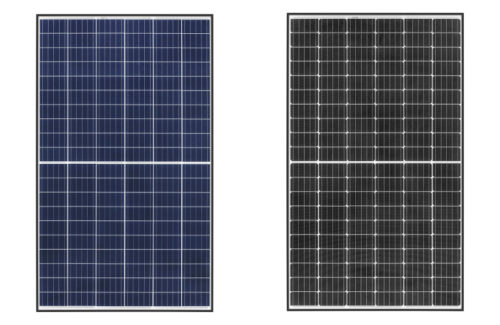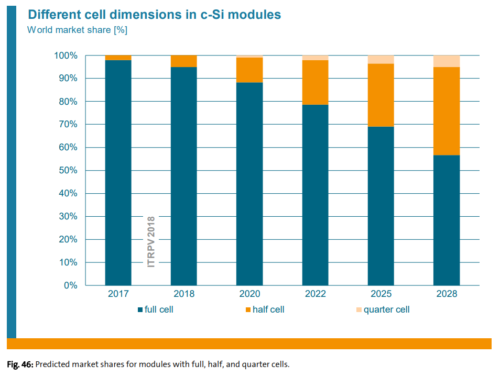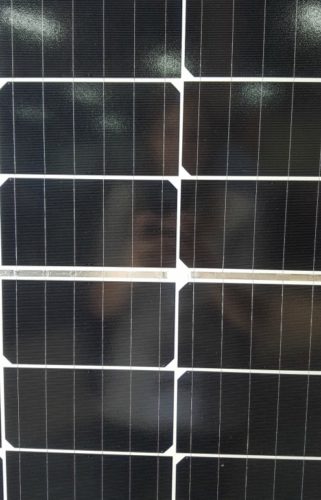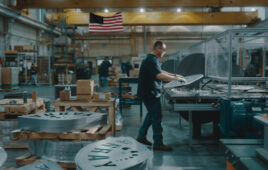Panel trends have a way of quickly becoming mainstream. IHS Markit predicted that passivated emitter rear cells (PERC) technology would go from a blip in the market in 2014 to mainstream by 2020—a prediction confirmed by anyone looking at panel models released this year. PERC is here to stay.
The next technology on that mainstream path is half-cell designs. The ninth edition of the International Technology Roadmap for Photovoltaic (ITRPV) predicts the market share of half cells will grow from 5% in 2018 to nearly 40% in 2028.
Half-cell modules have solar cells that are cut in half, which improves the module’s performance and durability. Traditional 60- and 72-cell panels will have 120 and 144 half-cut cells, respectively. When solar cells are halved, their current is also halved, so resistive losses are lowered and the cells can produce a little more power. Smaller cells experience reduced mechanical stresses, so there is a decreased opportunity for cracking. Half-cell modules have higher output ratings and are more reliable than traditional panels.
“When considering a solar installation, the idea of ‘more’ is at the forefront—produce more energy, save (or earn) more money and do more good for the environment,” said Cemil Seber, VP of global marketing and product management for module manufacturer REC. “In the case of rooftops where there is a limited amount of space available, using solar panels with half-cut cell technology can help.”
REC is a half-cell pioneer, first introducing the design in 2014. The company’s TwinPeak half-cell module series effectively turns each panel into two twin panels. Since the cells are smaller, inter-cell spacing doesn’t have to be as wide and they can be placed closer together. This allows REC to separate the panel into two. Independent upper and lower module halves lead to improved shading response. If the bottom half of a module is shaded, the top half will still perform.

REC’s polycrystalline TwinPeak half-cell module (left) and its monocrystalline N-Peak half-cell module (right)
REC has pushed the boundaries with half-cell designs in polycrystalline modules. REC’s half-cell PERC polycrystalline modules have reached 300 W, and they can compete with full-cell modules in the more efficient monocrystalline class. The company has been so impressed by the advantages of half-cells, it is transitioning all its manufacturing lines to the new technology.
“Since 2014, REC has been continuously transferring its production lines to half-cut cell technology,” Seber said. “Today, all but one of our module production lines in Singapore have been equipped for half-cut cell technology.”
During the 2018 tradeshow swing, REC released its new N-Peak series of modules, the company’s first stab at monocrystalline half-cells for even higher efficiency and output—up to 330 W in a traditional 60-cell footprint.
Other manufacturers have also started half-cell designs in the monocrystalline class. LONGi Solar recently exceeded 360 W in testing with its 120-cell half-cut monocrystalline PERC module. Hanwha Q CELLS received the Intersolar Award 2018 Photovoltaics category for its Q.PEAK DUO-G5 solar module—a 120-half-cell, six-busbar monocrystalline module. The Hanwha module uses round wires instead of flat ribbons for busbars to reduce shading on the cells. Hanwha also has half-cut designs for the 72-cell market, although in polycrystalline. Its Q. PLUS DUO L-G5.2 is a polycrystalline half-cell module with a maximum output of 370 W.
Since half-cell designs are the hottest trend right now, a manufacturer just has to update a few things on its lines to keep up. The two challenges with switching full-cell manufacturing to half-cell designs is the cell cutting and the stringing process. Since half-cells are usually PERC cells to begin with, the cell itself is quite fragile. Laser-cutting the cell down the middle without cracking it is a delicate process. Half-cells often use four or more busbars. Stringing these very narrow connection strips across a smaller footprint requires the use of precise equipment. Junction boxes are also different on half-cell modules. Most brands use multiple, smaller junction boxes so each module half can function as its own. Otherwise, half-cell module assembly is like full-cell production.
Since half-cell modules produce more power and are more efficient and reliable than their full-cell counterparts, their use can lead to time and money savings for the installer.
“By delivering more power per square meter, fewer panels are required to generate the same power,” Seber said. “This means quicker installation times and the need for fewer components such as clamps and racks—all of which reduces the overall costs.”






as far as I understand, if split cell panels behave exactly like full cell panels – 120 cell split panel will be seen as 60 cell panel (also called 20V panel) and be compatible with controller specification for 60 cell panel
Why not just cut them in half again?
Are splits cell panel wired in series then parallel .As compared to the traditional panel which one is likely to have high amp.
I didn’t realize split cells and full cells essentially no difference in wattage output – aside from shading.
Fantastic post! Ms. Kelly
I have a question.
By cutting the solar cells into 2 equal parts, it is true that the resistance is also reduced by 50% of each cell but the overall resistance of the complete solar panel remains the same.
Is it not that?
Or
Do we connect the half-cut solar panels in such a pattern of series and parallel combination that the overall resistance is less than it was when the cells were not cut?
I hope you understood my question.
Eagerly waiting for your reply.
Thank you
Yash 🙂
Great to see and read quality resources in regards to solar, more information needs be put out there for customers.
why are half cell panels more reliable that full cell panels ?
I guess because when bending occurs from thermal expansion, wind or people moving the panels, the panels can bend at the joints instead of potentially cracking the cells.
So where do the mIcro inverters mount when cables are in the middle? How to keep cables up off the roof?
Microinverters are typically mounted on the underside of the solar panel, near the top or bottom edge. If the cables are in the middle, the microinverters can be mounted in a few different ways:
If the solar panel is mounted on rails, the microinverters can be mounted on the rails between the panels, in line with the cables.
If the solar panels are mounted directly to the roof, the microinverters can be mounted on a bracket or rack that is attached to the roof between the panels, in line with the cables.
To keep the cables up off the roof, cable clips or cable ties can be used to secure the cables to the underside of the solar panels or the mounting structure. This can help protect the cables from damage and improve the overall appearance of the installation. Some microinverter manufacturers also offer cable management accessories specifically designed to keep the cables organized and out of the way.
Are they basically two modules in parallel?
Kind of, yes. But two smaller, square modules.
For some microinverters that are currently compatible with 60 cell and 72 cell solar panels like APSystems and Enphase, do 120split cell and 144 split solar modules still work with these types of inverters??
That’s a really good question. I’ll try to find an answer.
I have also same question and concern for my design to consider Ms. Kelly, hope you can address our concern.
“For some microinverters that are currently compatible with 60 cell and 72 cell solar panels like APSystems and Enphase, do 120split cell and 144 split solar modules still work with these types of inverters??”
The answer is yes, microinverters can work with half-cell solar panels, but check which model of microinverter you have for specific compatibility. Enphase states in its datasheets that its more recent micorinverters (7 and higher) do work with half-cell panels, but older versions may not.
Yes, split cell panels behave exactly like full cell panels of equivalent wattage. They just don’t suffer as much when shade hits just one section. e.g. from the bottom when in portrait mode. If shade hits both sections they loose output just as a full cell panel would. Electrically they still have just two wires out.
The inverter can’t tell the difference between low output from shading and low irradience.
This is a great question. Most of the Enphase microinverters indicate on their spec sheet that they support 120 and 144 cell modules.
The AP Systems only mention 60 and 72 cell, but they still should support them. As always, double check your module Voc and Isc to confirm and check with a sales rep.
So are they just offering this at a higher voltage or are they giving you two sets of outputs so you have the option to go either 24 volt or 48 volt? If you went 24 v you would be more shade resistant…
The output of the two sections is wired in parallel, so NO, you don’t get to do 48 volts.